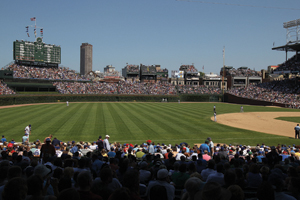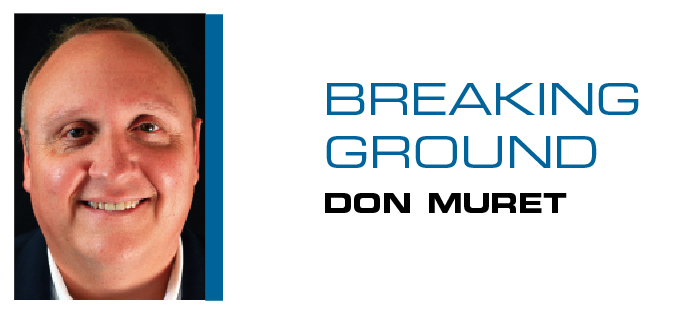The Chicago Cubs are rearranging a few group areas at
Wrigley Field to free up more room to mingle in the 97-year-old ballpark, where space is always at a premium.
The Bud Light Batter’s Eye, the stadium’s indoor lounge in center field, is one example. The Cubs are reconfiguring the long, narrow room, replacing two rows of long countertops with round tables to provide more space for people to move around.
The lounge opened in 2006 as part of the Cubs’ $13.5 million renovation of the outfield bleachers. The Batter’s Eye did not always sell out during the regular season, in large part because its press box-style layout restricted movement, Cubs officials said.
 |
GETTY IMAGES
The Bud Light Batter’s Eye at Wrigley Field looks in on the action from straightaway center field. |
In addition, the Batter’s Eye will have new windows that open slightly to give those premium ticket holders some fresh air and a greater sense of the sights and smells of the game. The old windows did not open, said
Carl Rice, vice president of ballpark operations.
As of last week, the Cubs had already seen a 9 percent increase in sales for the Batter’s Eye compared with last season, said Wally Hayward, executive vice president and chief sales and marketing officer. Tickets cost $165 to $295 a person, and the price includes a buffet meal.
Patrons told the Cubs to make the Batter’s Eye a more lively space, Hayward said. Throughout sports, teams have heard from their customers that they want the freedom to come and go as they please without being tied down to one location.
The new Batter’s Eye setup will be ready May 1, one month after Opening Day, Hayward said.
Separately, the Cubs have improved the look and feel of the Captain Morgan Club, an indoor-outdoor space just outside the ballpark. A new circular bar in the tented area should create more energy and excitement.
The Cubs had their concessionaire, Levy Restaurants, take over operations of the Captain Morgan Club from Harry Caray’s Restaurant Group, its proprietor since it opened for the 2009 season.
On the mezzanine level, 15 of Wrigley Field’s 60 suite holders took the Cubs up on an offer to renovate their individual units, Rice said. Each skybox owner paid for their own upgrades to refresh the interior and install new televisions. The minimum investment was $15,000.
The Cubs brokered a rate with a local construction firm and will not see any of that money, Hayward said. Those improvements should stay intact through the 2013 season at which point all suite interiors could change as part of the team’s proposed $300 million ballpark renovation.
For 2011, the biggest addition to the grandstand was installing 3,000 cup holders on the first row of every section except for the field boxes. Bank of America, which sponsors the 34,000 existing cup holders, asked the Cubs if they could put more in to provide greater brand exposure, Hayward said.
Rice could not say why those front rows never had cup holders other than to say it is always a challenge to retrofit existing seats at Wrigley.
All told, the upgrades add up to more than $3 million.
GIANT STEPS: The San Francisco Giants, always on tech’s cutting edge, have made several upgrades at AT&T Park to improve coverage for mobile devices and boost revenue at Centerplate’s concession stands.
In conjunction with AT&T, the Giants expanded the stadium’s distributed antenna system, which was installed before the 2010 season to enhance 3G smartphone coverage.
The original system quadrupled coverage compared with 2009 after the ballpark’s infrastructure “felt the load” from an increased number of fans using iPhones and other mobile devices, said Bill Schlough, the Giants’ senior vice president and chief information officer.
During the 2010 postseason, the ballpark’s IT backbone “again felt that pressure” with a dramatic increase in smartphone users uploading content and sharing that information with others during the playoffs and World Series, Schlough said.
The expanded system adds 119 antennas and 63 remote units and positions the facility to make a smooth transition to 4G technology in the coming years.
For concessions, the Giants decided to test 51 digital menu boards at 13 food and retail stands at a fraction of the seven-figure investment required to install a complete Internet protocol television platform, Schlough said.
Those LG flat-screens are powered by Ping HD technology that can show live video and produce commercials for specific products as fans wait in line to buy food, drink and merchandise. Coors Field and Safeco Field are also wired with Ping HD systems this season.
“The ability to do a pilot and clearly measure the result appealed to us,” Schlough said. “If we see a 6 percent lift in sales, which we expect it will, it would pay for the system in one year.”
The Giants and their food and retail vendor, Centerplate, shared the $200,000 investment.
Separately, AT&T also upgraded the stadium’s wireless network after the team’s data showed there were 10,872 mobile devices used during the first game of the World Series, compared with an average of 3,335 during the regular season. For 2011, AT&T has boosted Wi-Fi coverage by increasing access points to a total of 325 and migrating to a newly designed system first used during the Super Bowl at Cowboys Stadium.
JORDAN ON THE MOVE: Sports facility developer Bob Jordan has formed his own consulting firm after leaving his old job as vice president of design and construction for New Meadowlands Stadium.
Jordan’s new company is Venue Research and Design in Cold Spring, N.Y. Jordan has been hired by the University of Washington to assist with the school’s $250 million renovation of Husky Stadium.
Separately, Jordan is working for VTB Bank in Moscow as the Russian financial institution plans to develop a new stadium and arena in that city. Both groups toured New Meadowlands Stadium last fall.
Don Muret can be reached at dmuret@sportsbusinessjournal.com. Follow him on Twitter @BreakGround.





